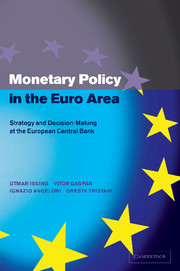Book contents
- Frontmatter
- Contents
- List of figures
- List of tables
- Acknowledgements
- Introduction
- 1 Money, output and prices: the scope of monetary policy
- 2 Monetary policy making: strategies and rules
- 3 The euro area: an overview
- 4 The ECB strategy: defining price stability
- 5 The role of money
- 6 A broadly based assessment
- 7 The ECB strategy: an overall view
- 8 The operational framework
- 9 Accountability and transparency
- 10 The single monetary policy in 1999
- Appendix Excerpts from ECB external communications to the press
- References
- Index
2 - Monetary policy making: strategies and rules
Published online by Cambridge University Press: 22 September 2009
- Frontmatter
- Contents
- List of figures
- List of tables
- Acknowledgements
- Introduction
- 1 Money, output and prices: the scope of monetary policy
- 2 Monetary policy making: strategies and rules
- 3 The euro area: an overview
- 4 The ECB strategy: defining price stability
- 5 The role of money
- 6 A broadly based assessment
- 7 The ECB strategy: an overall view
- 8 The operational framework
- 9 Accountability and transparency
- 10 The single monetary policy in 1999
- Appendix Excerpts from ECB external communications to the press
- References
- Index
Summary
Having discussed the issue of what monetary policy can accomplish, we go on to review the current academic thinking on ‘monetary policy making’, that is on how monetary policy makers can best achieve their objectives. The advances in this field of monetary economics have been remarkable in recent years. Nowadays, we have more precise ways to investigate the comparative effects of different policy actions within rigorous, quantitative frameworks. Nevertheless, though relying partly on theoretical results, actual policy making must also recognise the role of judgmental inputs. While welcoming the advances of the economic discipline, practical monetary policy must not be dazzled by the formal elegance and refinement of theoretical models. In spite of great improvements, formal models continue to be so highly simplified, with respect to the complexities of the real world, that their practical implications must be regarded with considerable caution.
Our starting point is the issue of ‘rules vs. discretion’. While in recent practical central banking experience simple rules are the exception – and, de facto, always linked to the adoption of a fixed exchange rate arrangement – the issue of rules vs. discretion is far from settled in the academic debate. After a brief account of the ‘old’ debate, in section 2.1 we review how this has been completely reshaped by the advent of the ‘time inconsistency’ literature. This literature has helped to clarify the distinction between discretion and activism and, more importantly, has highlighted the fundamental importance of credibility in monetary policy.
- Type
- Chapter
- Information
- Monetary Policy in the Euro AreaStrategy and Decision-Making at the European Central Bank, pp. 32 - 46Publisher: Cambridge University PressPrint publication year: 2001



